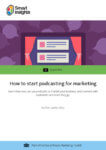How we created a top 10 iTunes podcast
Podcasts aren't maybe the hottest digital marketing technique, but I've personally found them to really effective in building an audience, awareness, driving website traffic and lead generation. In this post I'll show you how I've built my podcasts and go them into the top positions in the iTunes chart, the key place to build a podcast audience.
I started recording a podcast a number of years ago with no budget and no idea about podcasting. After much trial and error, the podcast became one of the world’s most popular digital marketing podcast (according to iTunes). Once I left the company I started my original podcast with, I went on to start the Digital Marketing Podcast, which is now a top 20 iTunes podcast worldwide. I'm not saying it's the Perfect Podcast, but it alliterates nicely, and I hope others find what we have learned useful so...
What made these Podcasts so successful and lead to so many thousands of downloads and subscribers? It boiled down to a few pretty simple things which I’ll outline for below.
How to start podcasting for marketing
Learn how to start using podcasting for marketing, from evaluating your internal resources and aims to planning, editing, and uploading your pilot episode. This Quick Win will have you set up and recording in no time!
Access the How to start podcasting for marketing quick win
7 tips on how to increase your Podcast downloads and subscribers

-
Tip 2: Sound Quality
Something I quickly realised was that recording with high quality sound was essential. From my own listening experience, I knew that I would very quickly stop listening to anything that was echoey, tinny or generally sounded cheaply and poorly recorded.The problem with this idea, is that creating good quality recorded audio is very difficult. Luckily I've been through the trial and error and pain of working out what works and what doesn't.Firstly, it doesn't need to be expensive.There are plenty of microphone that will do the job perfectly well, what's actually important is the environment you record in. I have sound proofed rooms with foam tiles, tried different mics, I have even recorded on the Isle of Wight with a towel over my head to stop echo (it's a long story). What I have actually found to make all the difference are these:
- 1. An audio reflector that sits just behind your mic and sucks up all of the echo. This means you need to speak very close to your mic, but it will get you great audio in most terrible recording environments.
- 2. a -5dB switch on my mic (you can often achieve the same from software settings). This meant that all of the background noise and most of the echo is filtered out. This switch has been the difference between the sound of recording in a big aircraft hangar and sounding like I'm in an audio booth.
Ideally you need a professional sound engineered room like an audio booth. Failing that get a reflector and a -5dB switch mic.
-
Tip 4: Length
We never record an episode longer than about 40 mins, with 20 mins being the average. The logic is that people listen to the podcast when they are travelling, quite often commuting by car or train. Anything longer wouldn’t be convenient for the audience.
-
Tip 6: Regularity
We publish the podcast regularly. It started monthly and is now every 2 weeks. It’s not a strict regime but we do try and get some new content out at least that regularly. This means you can maintain a flow of conversation and one recording can follow on from the previous one. It also keeps people interested and engaged enough to continue subscribing and not forget why they clicked that subscribe button in the first place.Realistically I think we could record a lot more regularly as long as we had enough original content. Feedback through Twitter has generally been weekly and would be the listeners preference, but it’s a matter of content.
-
Tip 7: Content and format development
The podcast is now quite different to how it started. Originally it was one podcast one topic. We now cover a couple of news items and often have an interview with somebody from the Digital Marketing world. This was a reaction to the whole world of podcasting developing and learning from our competitors.
News moves fast in the world of online marketing, and an online discussion of these top news stories and giving an informed opinion can go down very well.
We’ll continue to try new things, develop the format and continue reacting to listener input. I am now also recording more in depth single topic podcasts but I see these more as audio training. I think the combination suits people’s different requirements at different types.
These are just a few of the things we have found that have really helped make our podcast work. The key thing, like anything on the web, is create content that will be valuable to somebody.

Thanks to
Daniel Rowles for sharing their advice and opinions in this post. Daniel is Managing Director of
Target Internet and host of the popular
Digital Marketing Podcast. You can follow him/her on
Twitter or connect on
LinkedIn.





 Thanks to
Thanks to 


